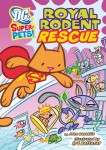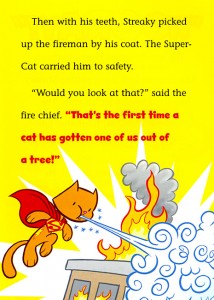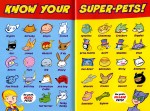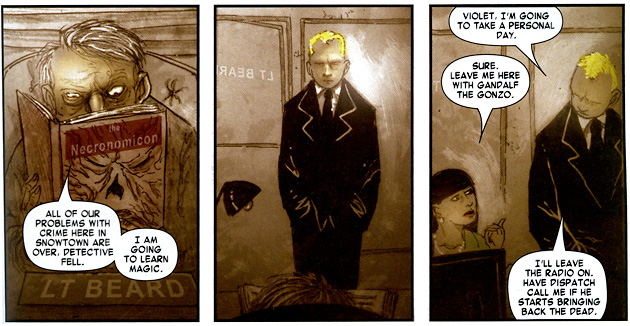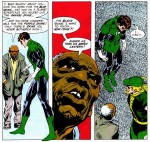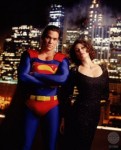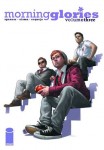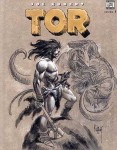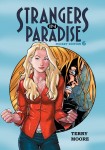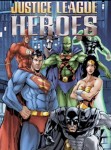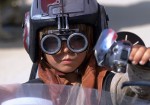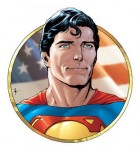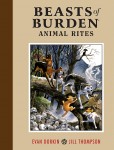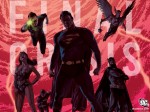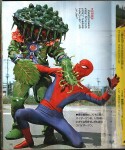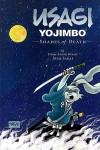 |
|
This review may contain spoilers. Skip To The Verdict? »
 The last time we saw 1930s mystery man Wesley Dodds, in Sandman Mystery Theatre Vol. 2: The Face and The Brute, his continued adventures were slightly burdened by predictable plotlines and an absence of a strongly defined artistic direction. It was still an enjoyable comic, with good characterization and setting, but not quite as strong as the first volume.
The last time we saw 1930s mystery man Wesley Dodds, in Sandman Mystery Theatre Vol. 2: The Face and The Brute, his continued adventures were slightly burdened by predictable plotlines and an absence of a strongly defined artistic direction. It was still an enjoyable comic, with good characterization and setting, but not quite as strong as the first volume.
This third book, Sandman Mystery Theatre Vol. 3: The Vamp, sets the status quo for the rest of the series as starting artist Guy Davis returns and writer Matt Wagner is joined by Steven T. Seagle (It’s A Bird).
The creative team gets down to business, opening the story with a gruesome scene in the finest Vertigo fashion. I’ve mentioned before that the series feels dreamlike, with hints of paranormal around the edges, but that the monsters here are – at their core – human.
That theme stands in this third volume. The presentation is certainly dramatic, stylized, but it sets itself as a matter of perception. This book takes place in the DCU at just the start of the fantastic age of heroes – before WWII, before Superman. It’s still a strange place (and always has been, perhaps), but not yet overrun with cyborg Nazis, mad scientists, and the alien invasion of the week.
Keeping this in mind, the artwork is astutely matched to the book’s themes. The David Hornung‘s colors, pastel and earth tone, give a hint of the eventual brightly popping pages of the coming era, but keeps the mood subtle, the city often darkly quiet, promising hints of action, intrigue, and a softly rumbling cultural revolution. (His colors are often so subtle that it is unfortunately hard to reproduce the skin tones used in the scans – I’ve done my best.)
Guy Davis fills the roster with regular joes – nary an over-muscled Adonis in sight. Our hero, after a brief presentation as a broad-shouldered Wayne-type in the last volume, is back to his endearing stature – short, slightly pudgy, and almost out of breath.
 The gals are enticing but real, beautiful lips and flawed, lined necks, lovely curves that still move to the demands of gravity. These awkwardly alluring bodies, male and female, are portrayed quite plainly with an mature sensibility refreshing to see in a comic by a major publisher.
The gals are enticing but real, beautiful lips and flawed, lined necks, lovely curves that still move to the demands of gravity. These awkwardly alluring bodies, male and female, are portrayed quite plainly with an mature sensibility refreshing to see in a comic by a major publisher.
Love scenes, both sordid and pleasant, aren’t shied away from – and while they are well within the limits of your standard Vertigo comic (tops and butts only) it makes for an adult comic I wouldn’t be embarrassed to be reading in company.
It’s odd, perhaps, that the artwork brings characters that feel so normal, because it is also highly stylized and very very weird.
It would be hard to say that Davis’ hands or faces are actually shaped “correctly.” But it doesn’t seem like he is an artist that is trying and failing, rather he just isn’t concerned at all with standard ideas of consistency. He’s obsessive in other ways, with his finely hatched shadows and emphases on expression over likeness.
For this story, Davis surprised me by becoming even more free with his stylistic symbolism – if just for a few panels. Without giving too much away (and it would be a major spoiler in this who-dun-it) the main villain, soon after the reveal, is in a brightly lit parlor scene and positively covered, sketched over, in shady vibrating hatches. As the other characters smile and chatter around them, this moment is shared with the reader alone, faintly reminiscent of distortion effects used in horror movies like The Ring. I didn’t expect it and it struck me.
My quibbles are minor – there is some digital blurring on the linework (around Wesley’s glasses, for example). It’s used in situations where things would be blurry, but I’ve never been a fan of that kind of alteration. Besides that, the book was solidly produced all the way through.
These artistic stylings work for the plot, which, while still driven by our developing lead characters Dian and Wesley, is more themed and focused in this volume. There is a horror story here, murders and sex, but alongside a positive trending character arc. Dian has always known there are dark things in life and has always had a deal of fun, but this book deals with her sexuality alongside the cultural shiftings of the surrounding society.
Our culture comes in waves of discovery, newfound acceptance, rebellion, bigot-ism, conservatism – turmoil by the clashing of cultures. The early 1930s were one of the more liberal times, similar in some ways to the 60s and 70s, before the war and post-war conservatism.
Sandman Mystery Theatre doesn’t push these concepts as the focus, but it doesn’t ignore them either. At the core, this book is a fairly standard murder investigation – psychopaths turning upon tormentors (perceived or actual), a string of murders, the investigating lovers at the center – but it’s set against the 30s backdrop.
The speakeasies, marijuana in the alleys and jazz spilling out the door. Dian’s first brush with lesbianism, her perceptions of Wesley as an inexperienced innocent. A lesser creative team could play these themes for sensationalism, but here they are handled as they should be – as complex issues.
By the title of the volume, you’re probably surmised that there’s some sort of female centered villainy afoot. There are aspects to the story that are familiar and it’s easy for a tale like this, where sex is used as a weapon, to become simplistic. It’s one that resonates, however, and by playing it off the parallel stories of Dian and Wesley, the authors avoid a one sided presentation of the sexually awakened woman.
This is all delivered subtly, in the quiet moments, alongside some scenes of visceral violence. The fights here, like the rest, feel awkwardly real, with grimaces of pain alongside decidedly un-heroic confrontations. These aren’t iconic strongmen trading blows back and forth across city blocks, these are two humans brutally clashing in tight enclosed rooms and scummy alleyways.
For example, a significant amount of space is devoted to Wesley Dodds writhing on the floor in pain, a bullet in his gut – and while his self-cure might be much more than I could handle, he is easier to sympathize with than most of the heroes on the paneled page. It’s a refreshing presentation, especially because we are used to seeing The Sandman masked and stoic – as he would wish us to see him – in the pages of JSA and similar titles. This glimpse inside his struggle is satisfying.
Similarly, perhaps the detective story is more intriguing because this is a time before extremely sophisticated forensics. We’re so used to some super-technologic science fiction style solution to every mystery that it’s good to see some old fashioned sleuthing.
Sandman Mystery Theatre Vol. 3: The Vamp continues the trend of closing the case in a tight four issue arc while building the characters’ personal stories. Everyone has moved forward, Wesley, Dian, even the lesser cast members like the foul mouthed lieutenant actually assigned to the cases our heroes are constantly meddling in.
I was told that this was one of the lesser volumes of the series but I found myself enjoying it immensely. I’m eagerly looking forward to the next book. If it turns out The Vamp is a lower point for this ongoing, then I must be in for a treat.
Verdict:
4.5 out of 5. A complex variety of ideas explored under the plot of a tight little murder mystery. Our lead characters continue to develop, with a wonderful focus on Dian and Wesley’s evolving relationship. Guy Davis’ return to the artistic helm is most welcome.
I can’t give it a perfect score because it’s still kind of obvious who the villains are, but this book left me more fulfilled than the previous volume.
Essential Continuity:
Yes, for the Golden Age Sandman. I believe the next volume will build on the events here.
Read first:
You should read Sandman Mystery Theatre Vol. 1: The Tarantula and Sandman Mystery Theatre Vol. 2: The Face and The Brute first.
Read next:
The next book is Sandman Mystery Theatre Vol. 4: The Scorpion. We’ll be looking into it soon as we review our way through the DC Universe!














